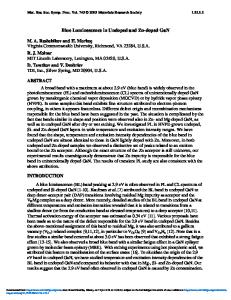2.2 eV Luminescence in GaN
- PDF / 273,565 Bytes
- 6 Pages / 414.72 x 648 pts Page_size
- 81 Downloads / 288 Views
"**
Physik Department E 16, Technische Universitat Munchen, D-85747 Garching, Germany Departimento de Fisica, Universidade de Aveiro, Portugal loffe Physico-Technical Insitute, St. Petersburg, Russia Department of Electrical and Electronic Engineering, Meiji University, 1-501 Shiogamaguchi, Tempaku-ku, Nagoya 468, Japan
ABSTRACT The yellow Luminescence in GaN centered at 2.2 eV has been studied in various epitaxial layers grown by MOVPE on sapphire and by the sandwich sublimation methode on 6H-SiC substrates. The photoluminescence and optically detected magnetic resonance results can be consistently explained by a recombination model involving shallow donors and deep donors. INTRODUCTION The near bandgap-luminescence efficiency of semiconductors is severly influenced by the presence of deep level defects in the bandgap. Therefore it is of importance to study the properties of these defects and, if possible, to identify their chemical nature which might help to avoid their presence in furture crystal growth experiments. For GaN its was realized quite early that a deep broad photoluminescence (PL) band located with its peak maximum at 2.2 eV is omnipresent [1]. In a photoluminescence (PL)
investigation on doped GaN microcrystals and needle like crystals it was shown that the properties of this PL band (i.e. the temperature dependence of its intensity and halfwidth as well as PL-excitation) can be described by a recombination model of randomly distributed shallow donors and deep acceptors - a model originally developed by Thomas and Hopfield [2]. In addition, from doping experiments evidence was obtained that carbon might be involved in the deep acceptor structure. In contrast in an optically detected magnetic resonance (ODMR) investigation on GaN epitaxial layers grown under various growth conditions the observed signals were attributed to shallow donors and deep donors, likely to be caused by an intrinsic defect [3]. The recombination mechanism for the 2.2 eV PL was explained by a recombination from a deep intrinsic double donor to a singly positively charged shallow acceptor. We have investigated the yellow lunilnesence in epitaxial GaN layers by PL, time resolvedPL, PL-excitation spectroscopy and ODMR. The results can be consistently explained by a recombination model involving shallow donors and deep donors. 619 Mat. Res. Soc. Symp. Proc. Vol. 395 ©1996 Materials Research Society
T= 2K
2--
02.0
2.5
3.0
3.5
Energy (eV) Figure 1: a) Low temperature photoluminescence spectrum of GaN/sapphire b) excitation spectrum of the optically detected magnetic resonance signals RESULTS AND DISCUSSION Two type of samples were used for the experiments: undoped GaN epitaxial layers grown by MOVPE on sapphire substrates and GaN epitaxial layers grown by the sandwich sublimation method on 6H-SiC substrates. The layer thicknesses of the MOVPE samples were about 3 pm. To improve the crystalline quality of the layers a 35 nm AIN buffer was grown at low temperatures. The n-type carrier concentrations of the layers as determin
Data Loading...











